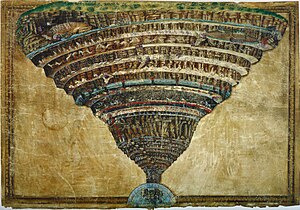Divine Comedy illustrated by Botticelli
| Divine Comedy Illustrated by Botticelli | |
|---|---|

The Map of Hell painting by Botticelli is one of the extant ninety-two drawings that were originally included in the illustrated manuscript of Dante's Divine Comedy commissioned by Lorenzo di Pierfrancesco de' Medici.
|
|
| Artist | Sandro Botticelli |
| Year | c. 1485 |
The Divine Comedy Illustrated by Botticelli is a manuscript of the Divine Comedy by Dante, illustrated by 92 full-page pictures by Sandro Botticelli that are considered masterpieces and amongst the best works of the Renaissance painter. The images are mostly not taken beyond silverpoint drawings, many worked over in ink, but four pages are fully coloured. The manuscript eventually disappeared and most of it was rediscovered in the late nineteenth century, having been detected in the collection of the Duke of Hamilton by Gustav Friedrich Waagen, with a few other pages being found in the Vatican Library. Botticelli had earlier produced drawings, now lost, to be turned into engravings for a printed edition, although only the first nineteen of the hundred cantos were illustrated.
In 1882 the main part of the manuscript was added to the collection of the Kupferstichkabinett Berlin (Museum of Prints and Drawings) when the director Friedrich Lippmann bought 85 of Botticelli's drawings. Lippmann had moved swiftly and quietly, and when the sale was announced there was a considerable outcry in the British press and Parliament. Soon after that, it was revealed that another eight drawings from the same manuscript were in the Vatican Library. The bound drawings had been in the collection of Queen Christina of Sweden and after her death in Rome in 1689, had been bought by Pope Alexander VIII for the Vatican collection. The time of separation of these drawings is unknown. The Map of Hell is in the Vatican collection.
The exact arrangement of text and illustrations is not known, but a vertical arrangement — placing the illustration page on top of the text page — is proposed by Barbara Watts as a more efficient way of combining the text-illustration pairs. A volume designed to open vertically would be approximately 47 cm wide by 64 cm high, and would incorporate both the text and the illustration for each canto on a single page.
The Berlin drawings and those in the Vatican collection were assembled together, for the first time in centuries, in an exhibition showing all 92 of them in Berlin, Rome, and London's Royal Academy, in 2000 and 2001.
...
Wikipedia
